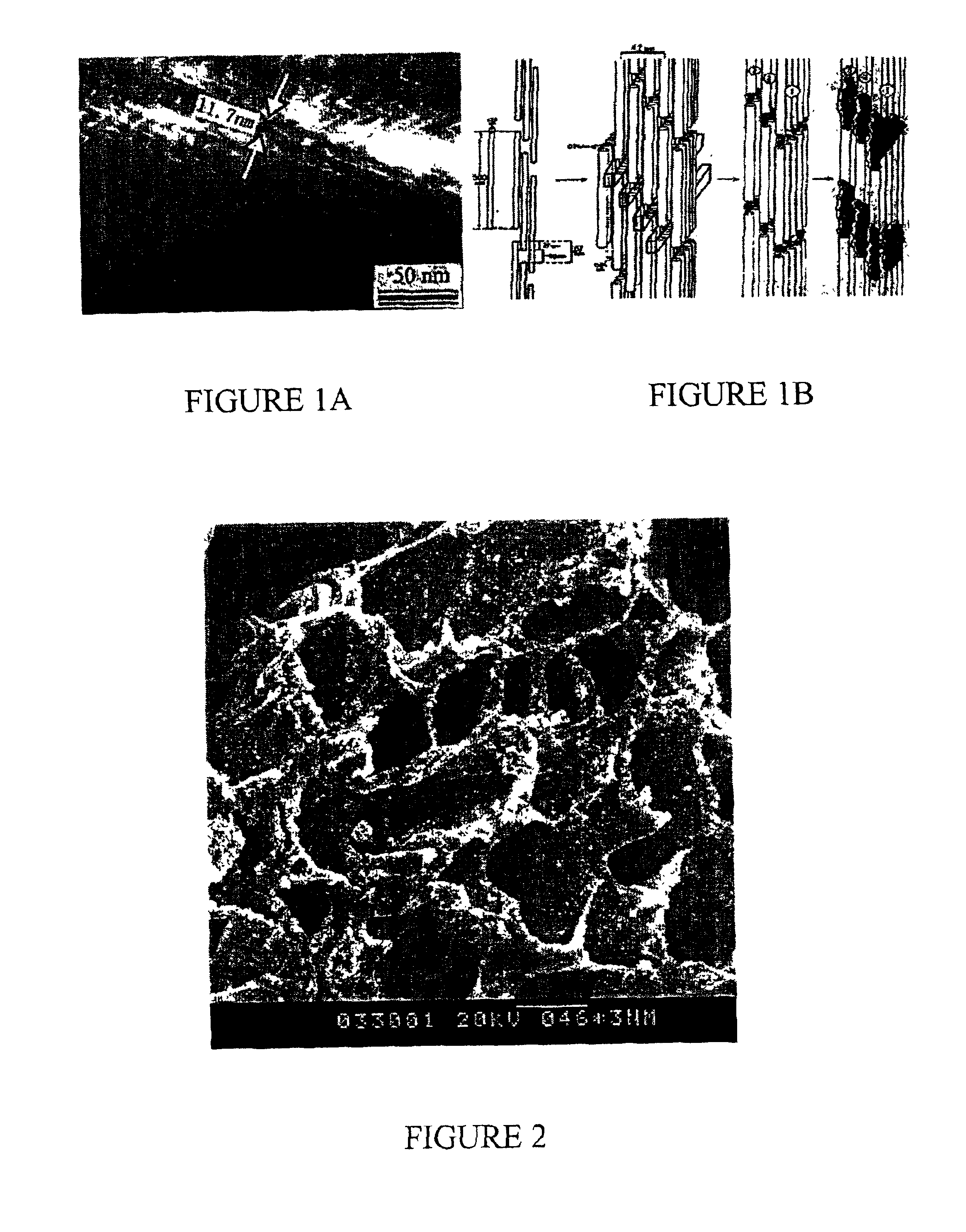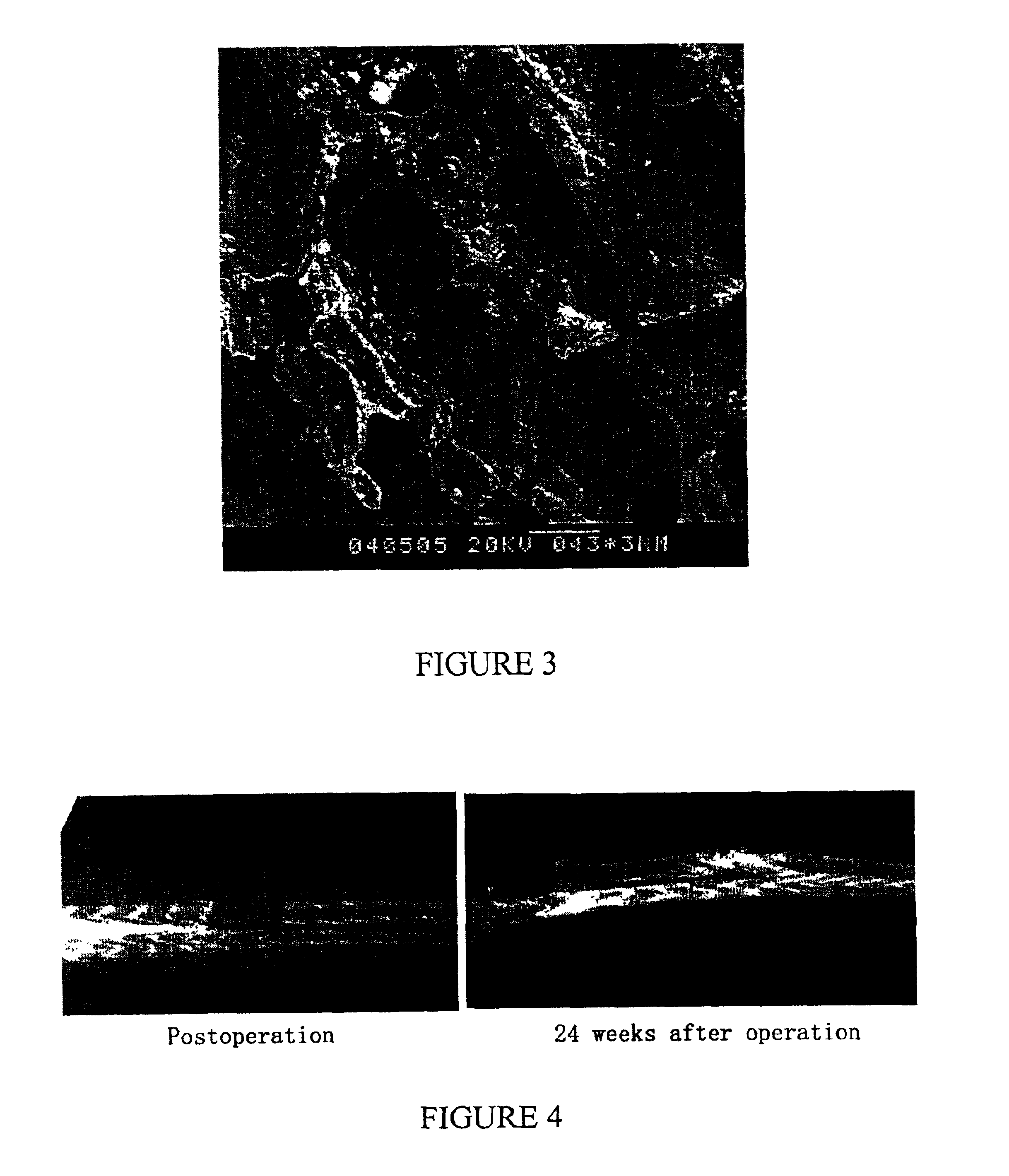Nano-calcium phosphates/collagen based bone substitute materials
a technology of calcium phosphates and collagen, applied in the field of bone substitute materials, can solve the problem that none of them can take the place of autogra
- Summary
- Abstract
- Description
- Claims
- Application Information
AI Technical Summary
Benefits of technology
Problems solved by technology
Method used
Image
Examples
example 1
Preparation of Nano-calcium Phosphates / collagen Composite
[0039]2 g type I collagen gel (1%) was dissolved in 30 ml 0.5M acetic acid. 11 ml of 0.1 mol / l Na2HPO4 and 18.3 ml of 0.1 mol / l CaCl2.6H2O were then added. The resultant solution was gently stirred at room temperature, and 0.5M sodium hydroxide solution was added in drops to adjust the pH to 7.4. With the increase of pH value, the solution became supersaturated gradually and calcium phosphates started to precipitate with collagen. The solution was maintained at pH 7.4 for 48 hours, after which the product was harvested by centrifugation at 5000 rpm. The product was then freeze dried and ground into fine powder, thus the composite was obtained.
example 2
Preparation of Bone Substitute Scaffolds
[0040]Dissolve PLA in dioxane and stir the solution at a temperature of 30° C. for 4 hours then add the prepared powder of Example 1 into the solution slowly. Several different ratios of PLA to nano-calcium phosphates / collagen composite powder were used, which are listed in Table 1. The mixed solution is treated with ultrasonic system (KQ-50B, Kunshan Co. Ltd, Beijing China) for 5 minutes to distribute the composite powder uniformly. Pour the resultant solution into a pre-shaped mould, which is made of Teflon, and freeze at 0° C. overnight. The frozen mould is then transferred into a freeze-drying machine (Alpha 1-2, Martin CHRIST Co. Ltd, Germany) for 72 hours to remove the dioxane crystals. The final products are strong scaffolds suitable for bone substitute.
[0041]
TABLE 1Start materials for the preparation of bone substitute materialsANano-calcium phosphate / collagen powder 0.3 gPLA (MW 100,000)0.7 gDioxane6 mlBNano-calcium phosphate / collagen...
example 3
Scaffolds for Used as Tissue Engineering Substitutes
[0042]Scaffolds of varying porosity and pore size were fabricated using the process of Example 2 and the start materials as listed in Table 2. The concentration of dissolving PLA in dioxane is 2.5% and 5%, respectively. The weight ratio of PLA to Nano-calcium phosphate / collagen composite is about 2:1. The solution is frozen at about −10° C. The obtained products possess an even higher porosity and bigger pore size, porosity is above 90% and pore size above 150 micrometer, both of these make the scaffold more suitable for tissue engineering by promoting cell activities such as cell migration and proliferation.
[0043]
TABLE 2Start materials for the preparation of tissue engineering substitutesANano-calcium phosphate / collagen powder 0.125 gPLA (MW 80,000)0.25 gDioxane10 mlBNano-calcium phosphate / collagen powder 0.25 gPLA (MW 100,000)0.5 gDioxane10 mlCNano-calcium phosphate / collagen powder 0.25 gPLA (MW 40,000)0.5 gDioxane10 ml
PUM
| Property | Measurement | Unit |
|---|---|---|
| thickness | aaaaa | aaaaa |
| diameter | aaaaa | aaaaa |
| weight ratio | aaaaa | aaaaa |
Abstract
Description
Claims
Application Information
 Login to View More
Login to View More - R&D
- Intellectual Property
- Life Sciences
- Materials
- Tech Scout
- Unparalleled Data Quality
- Higher Quality Content
- 60% Fewer Hallucinations
Browse by: Latest US Patents, China's latest patents, Technical Efficacy Thesaurus, Application Domain, Technology Topic, Popular Technical Reports.
© 2025 PatSnap. All rights reserved.Legal|Privacy policy|Modern Slavery Act Transparency Statement|Sitemap|About US| Contact US: help@patsnap.com


